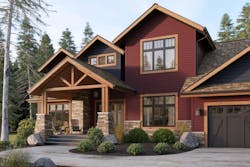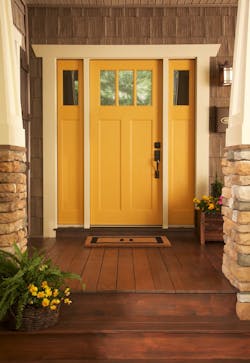Exterior Color 101
Looking for the perfect exterior colors for a remodel? No need to look far. When it comes to exterior color choices, the best guidance is closest to home. While neutrals, earth tones, and soft colors such as beiges, grays, reds, blues, and white are perennial favorites in many parts of the country, selecting the right variation of these shades makes a big difference. Design experts advise remodelers and homeowners to choose colors carefully, in the context of the house, its surroundings, and its location.
Zooming In
Start with the house itself—specifically those features that aren’t going to change. The colors of the roofing, brick, mortar, stone facing or accents, and other structural elements can spark ideas for complimentary new siding and trim colors, and can help rule out shades that will clash or not fit in. This goes for new stone veneer, which is popular these days for facing entire walls or for water table accents.
Look around the house too. Trees, shrubbery, flowering plants, and other landscaping features play a role in color selection. They may cast shadows that darken the look of the house. And, along with grasses and other surface materials, they contribute color elements that are part of the overall color effect of the property.
Siding style and surface texture also influence color effects. Michelle Forchetti, marketing manager for LP SmartSide engineered wood trim and siding, says that siding with deeper grain catches and reflects light differently from smooth-finish siding, often making the color seem darker. Lap lines create more noticeable shadow lines in sunny exposures and on light-colored siding, she adds. Colors used on panel siding tend to look lighter because there is less shadowing. Some homeowners may like the added detail of shadow lines; others may find it too busy.
The architectural style of the house carries a color message as well. Neutrals and soft hues often work nicely for traditional styles such as colonial, Tudor, and Craftsman. Pastels and earth tones show well on Mediterranean-style houses. Color choices and combos for Victorian houses can be far more adventurous and still be in character. And don’t forget the houses nearby. Your project “has to connect with the fabric of the community,” says design/build contractor Michael Sauri, of TriVistaUSA, in Arlington, Va.
Jackie Jordan, director of color marketing for paint manufacturer Sherwin-Williams, recommends taking a drive around the area to get a sense of the prevailing house colors. Choose colors that blend to a certain degree with those, she advises, to reinforce the character of the area and to be a good neighbor. Going with complimentary colors is especially important with attached houses.
UV radiation issues—the potential for distortion and color fading—have traditionally been concerns with dark siding colors because they absorb more heat. However, new technologies have allowed warranties against fading and heat distortion. (Shown here: Mastic Home Exteriors by Ply Gem siding with SolarDefense Reflective Technology.)
Location Matters
Exterior color preferences vary by region across the country, and for good reason. Certain color palettes are most successful in specific natural settings, from forested mountains to grassy plains to sun-drenched coasts. Sunny waterfront areas where flowers bloom year round invite bright, light exterior colors. Earth tones partner well with the landscape in dry, desert areas. Climate comes into play as well, with gray tones complementing the skies of the rainy Northwest.
Shades of color are affected by a region’s overall lighting. Forchetti says, “The atmosphere in northern climates tends to cast a cooler light, which can make beige go green or even slightly blue. The atmosphere in southern climates tends to cast a warmer light, which can make the same beige go pinkish. This is why on-site testing of colors is of the utmost importance when choosing neutral body/siding colors.”
More sunlight means more UV radiation and potentially more distortion and color fading. That’s of particular concern for dark colors because they absorb the most heat. Manufacturers have applied new technology to solve that problem. Jerry Blais, senior vice president of marketing for the Ply Gem Siding Group, for example, says his company uses Solar Defense Reflective Technology to produce new, dark colors of Mastic Home Exteriors vinyl siding products that are warranted not to fade or suffer heat distortion; the new palette was introduced in April 2015.
Homeowners are getting the message. For years, says Jerry Willing of Berger Custom Exteriors, in Guilford, Ind., the company’s Cincinnati-area clients opted for light vinyl siding with dark trim, in part to avoid the problems of UV damage. Today Berger is getting more requests for darker siding with lighter trim. “People were asking [for darker siding] for a long time,” he says, but fade-resistant vinyl “has only been available in the last few years. Now people know it’s out there” and they want it.
Blais says dark colors in rich, full-bodied shades have become popular choices for cladding and trim. Jordan, of Sherwin-Williams, also is seeing a trend in some areas toward darker siding paired with lighter trim. At the same time, in areas such as the Midwest, mid-Atlantic, and mid-South, lighter siding colors with darker trim are also in demand, Forchetti says. Preferences can even be city-specific. Exovations, an exterior remodeling specialist in Atlanta, is finding a tendency toward light siding and lighter trim, according to Jennifer Dreher, Exovations’ architectural designer. “When people are ready for a change, they are ready for a real change,” she says. Exovations clients “typically are coming from a darker and faded color, so they are choosing the lighter and fresher look,” Dreher says, selecting light neutral shades or softer colors with a lighter or white trim to brighten up the house.
Attracting interest in many regions is fade-resistant siding that looks like wood. Ply Gem has vinyl siding in variegated cedar-like tones across product lines. Many of LP’s Preferred Prefinishers offer engineered wood products with a durable two-tone wood stain look that appeals to homeowners in tree-rich zones such as the Northwest, Midwest, and Northeast.
Standing Out
While it’s wise to pick siding and trim colors that fit in and won’t lose their appeal over time, many homeowners also want to make a style statement using color. Most are doing it with elements of the house that are easy to repaint or change. The No. 1 choice is front doors. Allie Mann, a designer with Case Design/Remodeling, in metroHomeowners often stick with conservative siding and trim tones but opt for a splash of color on the front door, such as this Ply Gem Craftsman door in bright yellow (right).
Similarly, homeowners are also playing with color on garage doors. Manufacturer Wayne Dalton introduced TruChoice, a color mixing system that can produce sealed, baked-on, durable coatings for steel garage doors in a choice of 6,000 colors. Remodelers and homeowners either select from a palette of 200 classic colors, specify a paint manufacturer’s color, or provide a paint sample for the Wayne Dalton computer to match. Sarah Schram, brand marketing manager for Wayne Dalton, says that clients can go with a neutral tone so their garage door matches the house perfectly, or they can opt for a vibrant color, such as the Jimmy Buffett fan who ordered a door in Jimmy Buffett Pink. Either way, there are plenty of options for making a savvy color statement to suit individual tastes. PR
See more tips for exterior color selection
---
Wendy A. Jordan is a freelance writer based in Washington, D.C.


